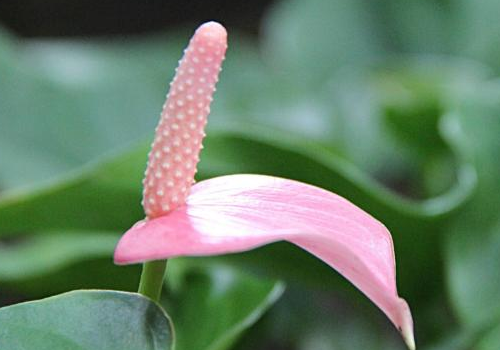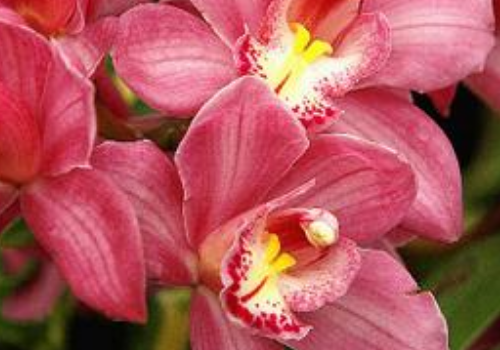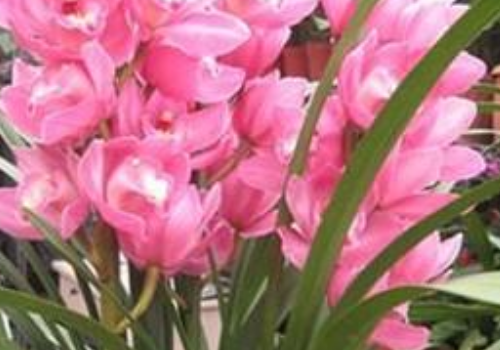What is the difference between pink palm and red palm and white palm? what about the rotten roots?
Pink palm is very suitable for family cultivation, with evergreen leaves and beautiful flowers. What is the difference between pink palm and red palm and white palm? What about the rotten roots:
What is the difference between pink palm and red palm and white palm:
1. The difference in shape
Pink palm shape: leaves extracted from the rhizome, long stalked, solitary, oblong heart-shaped or oval, dark fresh green, shiny.
The shape of the white palm: it is only half wrapped for the scape.
The shape of Anthurium andraeanum: scape is vertical.
2. The difference of moral meaning
The moral of pink palm: yearning for love.
The moral of White Palm: plain sailing.
The moral of Anthurium andraeanum: great ambition, heart to heart, and good luck.
3. The difference between petals
Petals of pink palm: fleshy inflorescences sessile, Terete, erect, slightly decumbent. Flowers bisexual, perianth with four lobes.
The petals of Anthurium andraeanum are much thicker than those of white palms.
White palm petals: some like calla lilies, and Guangdong evergreen Buddha bud is also very similar.

What about the rotten roots of pink palms:
1. Soil and water conversion
If the pink palm was cultivated in soil before, when changing to hydroponic culture, you must remember to wash the roots clean, and do not have too much water, and the roots should only be soaked to half of the water or 2 bumps to 3, otherwise the roots will rot easily.
Before the new root grows, change the water frequently and clean it up in time when you see the rotten root. Usually should pay attention to change water, hot weather generally 20 days to change, cold weather can be changed once a month and a half.
2. Water source problem
Do not directly use the fresh tap water, put it for two days, release the chlorine and reuse it, or you can buy some special hydroponic nutrient solution. When you see muddy water when watering, be sure to change the water again to keep the water clean.
In addition, the water temperature is also very important, when the temperature is higher than 30 degrees, the saturated dissolved oxygen of the water will be reduced, and if it does not reach the critical value needed by the powder palm, there will be rotten roots, so control the water temperature.
Now you can tell the difference between pink palm, white palm and red palm.
What is the difference among pink palm, red palm and white palm? what are the breeding methods and matters needing attention of pink palm?
Pink palm is a kind of perennial evergreen herbaceous flower, the color is mainly pink, the flowering period is long, the plant is tall, and has high ornamental value. The most obvious difference between it and Anthurium andraeanum and white palm is the color. Many flower friends who do not know them will mistakenly think that they are the same, but the color is different. In fact, Ziyao carefully observed it, or will find that there are many differences.
What's the difference between pink palm, red palm and white palm?
1. The difference in shape
Pink palm shape: leaves extracted from the rhizome, long stalked, solitary, oblong heart-shaped or oval, dark fresh green, shiny.
The shape of the white palm: it is only half wrapped for the scape.
The shape of Anthurium andraeanum: scape is vertical.
2. The difference of moral meaning
The moral of pink palm: yearning for love.
The moral of White Palm: plain sailing.
The moral of Anthurium andraeanum: great ambition, heart to heart, and good luck.
3. The difference between petals
Petals of pink palm: fleshy inflorescences sessile, Terete, erect, slightly decumbent. Flowers bisexual, perianth with four lobes.
The petals of Anthurium andraeanum are much thicker than those of white palms.
White palm petals: some like calla lilies, and Guangdong evergreen Buddha bud is also very similar.
Culture methods and matters needing attention of powder palm
First, the culture method of powder palm.
1. Lighting
Pink palm likes shade, so it is best to put it in the shade during maintenance, but it does not mean that there is no light at all. if you avoid the light completely, the plant will lose its luster. So it is good to have proper shade in the sun. If the light is not strong in winter, you can rest assured that you don't have to shade and accept the sun.
2. Temperature
Powder palm likes the warm environment, afraid of high temperature is also afraid of cold, the most suitable temperature for its growth is 19-25 ℃, when the summer temperature is too high, we should pay attention to it, generally, the temperature above 25 degrees should be ventilated in time, evacuate the high temperature, the temperature higher than 32 degrees may stop growing. Winter temperature is low, should pay attention to anti-freezing, when the temperature is lower than 13 degrees, it will enter the dormant period, can be moved to indoor, or wrapped with plastic bags.
3. Soil
It is best to choose fertile soil with loose air permeability and good drainage. Peat soil or rotten leaf soil can be mixed with perlite to form nutritious soil, or certain base fertilizer can be added to ensure the nutrients of the soil.
4. Watering
Powder palm likes to be moist and is afraid of drought, so it is important to keep the basin soil moist, and the water had better be a little acidic. If you need a lot of water in summer, you can water once a day or two, but do not accumulate water. It is easy to rot your roots when soaked in water for a long time. When the weather is too dry, you can spray some water on the leaves and reduce watering in winter.
5. Fertilization
The soil is fertile and nutritious, and the plant grows well naturally, so proper fertilization can be carried out during the growth period. Generally in the morning and evening fertilization, the effect will be better, fertilizer can choose liquid fertilizer, nitrogen fertilizer, phosphate fertilizer, potash fertilizer and so on.
II. Matters needing attention in powder palm culture
1. Flowerpot selection
Choose according to the size of the plant, not too large, otherwise the soil will dry very slowly after receiving water, affecting the root growth.
2. Replacement of basin soil
The pot must be changed in time so as not to affect the normal growth of the plant. Be careful when changing pots, so as not to damage the roots.
3. Watering management
Avoid stagnant water, just keep the soil moist, do not water at night in winter, the temperature at night will be much lower than during the day, so that the roots are easy to frostbite.
4. the problem of diseases and insect pests
Leaf blight is still a common disease, which can be sprayed once a month with fungicides such as Shiduqing, Manganese Zinc and so on. Termites. Aphids are relatively common pests, which can be removed with brushes and brushes when the number is small, so as not to harm the leaves.
Is the powder palm poisonous?
The pink palm is poisonous. The flower of pink palm can be slightly toxic, but you should be careful not to eat it and don't touch it easily.
So the powder palm is poisonous; the toxicity of the powder palm is mainly in the sap species in the stem, when the powder palm is trimmed, the juice will flow out, that is toxic, so be careful not to touch the juice, if you do, wash it with water immediately.
Brief introduction of Powder Palm
1. Alias
Pink Champion, Candle, an Zuhua
2. Growth habits
Pink palm is a perennial evergreen herbaceous flower, which is native to the tropical rain forest of Colombia in South America, where the environment is hot and humid, and the soil is rich in humus, which is the basis of its growth.
Pink palm is suitable for growing at a temperature of about 25 degrees. In order to ensure its healthy growth, the temperature should not be too high or too low. Pink palm requires less light, can not see full light, only need low light culture.
3. Flower language
Represents a fiery and sincere heart, but also contains the yearning for beautiful love.
Through the introduction above, you must know more about pink palm, right? In addition, we need to pay special attention to the fact that the powder palm has a certain toxicity, and it must not be eaten in the process of breeding, nor should it be easily touched. If placed indoors, pay more attention to children.
Is the pink palm poisonous? can the pink palm be put in the indoor bedroom?
When it comes to pink palm, although it is not as common as red palm and white palm, the color of pink palm looks particularly warm, elegant and soft, and many people prefer to plant refreshing pink palm. However, the seemingly warm pink palm, there are many people think that pink palm has a certain toxin, it is best not to put it indoors, so is this statement correct in the end?
Is the powder palm poisonous?
The flower of pink palm can be slightly toxic, but you should be careful not to eat it and don't touch it easily.
So the powder palm is poisonous; the toxicity of the powder palm is mainly in the sap species in the stem, when the powder palm is trimmed, the juice will flow out, that is toxic, so be careful not to touch the juice, if you do, wash it with water immediately.
Can I put the pink palm in the indoor bedroom?
Because it is toxic and it is not safe to have children at home, it is best to breed the powder palm outdoors, but it can also be raised indoors, as long as it is put on the balcony and other places that the children can't touch.
Moreover, the powder palm can help you absorb benzene and trichloroethylene in the air and purify the air.
Basic needs of powder palm culture
1. Lighting
Pink palm likes shade, so it is best to put it in the shade during maintenance, but it does not mean that there is no light at all. if you avoid the light completely, the plant will lose its luster. So it is good to have proper shade in the sun. If the light is not strong in winter, you can rest assured that you don't have to shade and accept the sun.
2. Temperature
Powder palm likes the warm environment, afraid of high temperature is also afraid of cold, the most suitable temperature for its growth is 19-25 ℃, when the summer temperature is too high, we should pay attention to it, generally, the temperature above 25 degrees should be ventilated in time, evacuate the high temperature, the temperature higher than 32 degrees may stop growing. Winter temperature is low, should pay attention to anti-freezing, when the temperature is lower than 13 degrees, it will enter the dormant period, can be moved to indoor, or wrapped with plastic bags.
3. Soil
It is best to choose fertile soil with loose air permeability and good drainage. Peat soil or rotten leaf soil can be mixed with perlite to form nutritious soil, or certain base fertilizer can be added to ensure the nutrients of the soil.
4. Watering
Powder palm likes to be moist and is afraid of drought, so it is important to keep the basin soil moist, and the water had better be a little acidic. If you need a lot of water in summer, you can water once a day or two, but do not accumulate water. It is easy to rot your roots when soaked in water for a long time. When the weather is too dry, you can spray some water on the leaves and reduce watering in winter.
5. Fertilization
The soil is fertile and nutritious, and the plant grows well naturally, so proper fertilization can be carried out during the growth period. Generally in the morning and evening fertilization, the effect will be better, fertilizer can choose liquid fertilizer, nitrogen fertilizer, phosphate fertilizer, potash fertilizer and so on.
The growth habit of pink palm
1. Temperature: the optimum growth temperature of pink palm is 20-28 ℃, and the highest temperature should not exceed 35 ℃. If the temperature is too high, it will grow badly, and the lowest temperature is 14 ℃. Freezing injury may occur at any time when the temperature is lower than 10 ℃.
2. Humidity: the optimum air relative humidity of powder palm is 700.80%, which should not be less than 50%. Low humidity, rough leaves and palms, poor glossiness and low ornamental value.
3. Illumination: the optimum light intensity of pink palm is 10000~20000Lux, which can not be seen at any time, and winter is no exception. It is suitable to be cultivated in low light with proper shade throughout the year. The strong light burned the leaves and affected the normal growth of the plant.
As mentioned above, the powder palm seems harmless, but it is actually slightly toxic. The main reason is that there are toxins in its juice, so it is best not to put it indoors or where children can get it. Although this toxin has no effect on adults, children's resistance is poor, so it is best not to let them touch it.
- Prev

How to prune Cymbidium and what kind of soil is used for flower culture?
Cymbidium is a kind of plant that many people like, which has a certain ornamental value. How to prune the flower branches of Cymbidium? What kind of soil is used for breeding? How to prune the flower branches of Cymbidium: 1. Cut off the flower branches from below, which not only does not affect beauty, but also ensures that it does not consume too much nutrients. In addition,
- Next

What is the reason for the yellowing of the leaf core of Cymbidium?
Many people are growing Cymbidium, but some of them will turn yellow. What is the reason why the leaf core of Cymbidium turns yellow? What shall I do? one。 Yellow Cymbidium caused by poor light is a sunny plant, but it can't stand strong light. Generally, astigmatism is the best, even if the light is too weak.
Related
- Fuxing push coffee new agricultural production and marketing class: lack of small-scale processing plants
- Jujube rice field leisure farm deep ploughing Yilan for five years to create a space for organic food and play
- Nongyu Farm-A trial of organic papaya for brave women with advanced technology
- Four points for attention in the prevention and control of diseases and insect pests of edible fungi
- How to add nutrient solution to Edible Fungi
- Is there any good way to control edible fungus mites?
- Open Inoculation Technology of Edible Fungi
- Is there any clever way to use fertilizer for edible fungus in winter?
- What agents are used to kill the pathogens of edible fungi in the mushroom shed?
- Rapid drying of Edible Fungi

